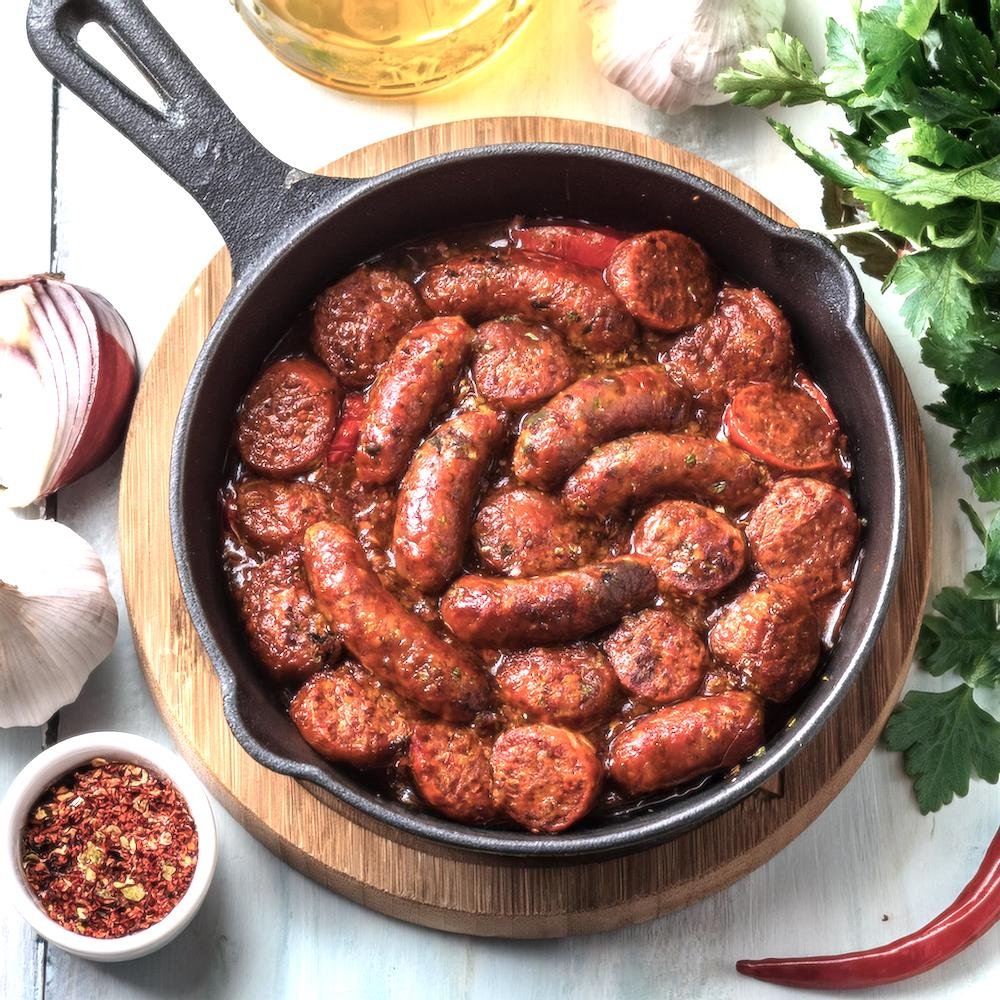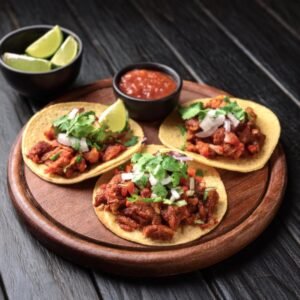Beef Chorizo is a flavorful and versatile sausage that has become a staple in many global cuisines. Known for its bold and spicy flavor, this sausage is made primarily from ground beef and a mix of aromatic spices, offering a rich and savory addition to a variety of dishes.
While pork chorizo may be more common, this recipe provides a great alternative for those who prefer beef or follow dietary restrictions that avoid pork. Its unique flavor profile makes it an ideal ingredient for tacos, breakfast hashes, soups, and much more.
In this guide, we’ll explore what beef chorizo is, how it differs from pork chorizo, key ingredients, cooking methods, and popular recipes to try at home.
What Is Beef Chorizo?
Is a type of sausage made from ground beef and a blend of spices, including paprika, garlic, and chili powder. It is typically seasoned to achieve a smoky, slightly spicy flavor that pairs well with many dishes.
Origins of Beef Chorizo
- Spanish and Mexican Influence:
- Chorizo originated in Spain, traditionally made with pork and flavored with smoked paprika.
- Mexican chorizo evolved with bolder spices and variations, including the use of beef as a primary protein.
- Why Beef Chorizo?
- It’s became popular as a pork-free option, catering to dietary preferences and cultural practices.
Difference Between Beef and Pork Chorizo
- Protein Source:
- Beef chorizo uses ground beef, while pork chorizo relies on ground pork.
- Flavor Profile:
- Pork chorizo often has a slightly sweeter and richer taste due to the natural fat in pork.
- Beef chorizo has a heartier and meatier flavor, with spices playing a prominent role.
- Texture:
- Beef chorizo can be leaner than pork chorizo, which affects its texture when cooked.
Pro Tip: If you prefer a leaner sausage with bold, smoky flavors, beef chorizo is an excellent choice.
Key Ingredients
The bold flavor of beef chorizo comes from its unique blend of spices and seasonings. These ingredients work together to create the sausage’s signature smoky, spicy, and savory profile.
Core Ingredients
- Ground Beef:
- The primary ingredient, providing a hearty, meaty base.
- Lean ground beef (80/20 or 85/15) works well for balancing flavor and texture.
- Paprika:
- Adds a smoky sweetness and vibrant red color to the sausage.
- Smoked paprika enhances the depth of flavor.
- Chili Powder:
- Delivers the characteristic heat and spiciness of chorizo.
- Variations like ancho or chipotle powder can add unique smoky undertones.
- Garlic:
- Provides a pungent, aromatic element that complements the beef and spices.
- Fresh garlic or garlic powder works equally well.
- Cumin:
- Adds an earthy, slightly nutty flavor that balances the heat from the chili powder.
- Vinegar:
- A splash of vinegar (typically apple cider or white vinegar) brightens the flavor and tenderizes the beef.
Optional Ingredients
- Oregano:
- A common addition in Mexican-style beef chorizo for herbal notes.
- Cayenne Pepper:
- For extra heat, cayenne pepper can be added in small amounts.
- Onion Powder:
- Enhances the overall flavor without overpowering the other spices.
- Brown Sugar:
- Adds a hint of sweetness to balance the spiciness.
Variations of Beef Chorizo
- Spicy Beef Chorizo:
- Incorporate extra chili powder, cayenne, or red pepper flakes for a spicier version.
- Mild Beef Chorizo:
- Reduce the chili powder and use sweet paprika for a milder flavor.
- Herbed Chorizo:
- Add fresh cilantro or parsley for a unique twist on the traditional recipe.
Pro Tip: Customize the seasoning blend to suit your taste, whether you prefer a fiery heat or a milder flavor profile.
How to Cook Beef Chorizo
Beef chorizo is incredibly versatile and can be cooked using various methods. Whether you’re making tacos, casseroles, or breakfast dishes, these techniques will help you achieve delicious results.
Pan-Frying
- Why It Works:
- Pan-frying brings out the flavors of beef chorizo and creates a slightly crispy texture.
- Steps to Pan-Fry Beef Chorizo:
- Heat a non-stick or cast-iron skillet over medium heat.
- Remove the chorizo from its casing (if applicable) and add it to the skillet.
- Break the meat into small pieces with a wooden spoon or spatula.
- Cook for 8–10 minutes, stirring occasionally, until fully browned and cooked through.
Pro Tip: Use the rendered fat from the chorizo to flavor other ingredients like onions, peppers, or eggs.
2. Adding to Soups and Stews
- Why It Works:
- The rich flavor of beef chorizo enhances the taste of broths and stews.
- How to Add It:
- Brown the chorizo in a skillet before adding it to your soup or stew.
- This step enhances the flavor and ensures the chorizo is evenly distributed in the dish.
Pro Tip: Add chorizo to dishes like chili, lentil soup, or pozole for a smoky, spicy kick.
3. Grilling or Baking
- Why It Works:
- Grilling or baking creates a crisp exterior while keeping the inside juicy.
- Works best for chorizo in sausage form.
- Steps to Grill or Bake:
- Grilling: Preheat the grill to medium heat. Grill chorizo links for 8–10 minutes, turning occasionally.
- Baking: Preheat the oven to 375°F (190°C). Place chorizo on a baking sheet and bake for 20–25 minutes, flipping halfway through.
Pro Tip: Pair grilled or baked chorizo with grilled vegetables or serve it in a bun for a flavorful sausage sandwich.
4. Mixing into Casseroles or Pasta
- Why It Works:
- Beef chorizo adds bold flavor and richness to baked dishes.
- How to Incorporate It:
- Brown the chorizo before mixing it into your casserole or pasta sauce.
- Bake the dish according to the recipe, allowing the flavors to meld together.
Pro Tip: Use chorizo in baked ziti, lasagna, or stuffed peppers for a creative twist on classic recipes.
5. Making Breakfast Dishes
- Why It Works:
- The bold spices of chorizo pair perfectly with eggs and potatoes for a hearty breakfast.
- Steps for Breakfast Dishes:
- Cook chorizo in a skillet, breaking it into small pieces.
- Add scrambled eggs, diced potatoes, or hash browns to the skillet and stir until combined.
- Top with cheese or fresh herbs for extra flavor.
Pro Tip: Try using beef chorizo in breakfast burritos or as a topping for avocado toast.
Homemade Beef Chorizo Recipe
Making beef chorizo at home is easier than you think. With simple ingredients and a few steps, you can customize the flavors to suit your preferences and enjoy fresh, flavorful chorizo anytime.
Ingredients
- Ground Beef:
- 1 pound of lean ground beef (85/15 works best for balance).
- Spices:
- 2 tablespoons smoked paprika.
- 1 tablespoon chili powder.
- 1 teaspoon garlic powder.
- 1 teaspoon onion powder.
- 1 teaspoon cumin.
- ½ teaspoon cayenne pepper (optional for heat).
- Salt and Pepper:
- 1 teaspoon salt.
- ½ teaspoon black pepper.
- Vinegar:
- 1 tablespoon white or apple cider vinegar.
- Optional Ingredients:
- 1 teaspoon oregano.
- ½ teaspoon red pepper flakes.
Instructions
Step 1: Prepare the Seasoning Blend
- Combine all spices, salt, and pepper in a small bowl. Mix thoroughly to create a uniform blend.
Step 2: Mix the Chorizo
- Place the ground beef in a large mixing bowl.
- Sprinkle the seasoning blend evenly over the meat.
- Add the vinegar to the bowl.
- Using clean hands or a spatula, mix the beef, spices, and vinegar until fully incorporated.
Pro Tip: Be gentle when mixing to avoid overworking the meat, which can affect the texture.
Step 3: Rest the Chorizo
- Cover the bowl with plastic wrap and refrigerate for at least 1 hour to allow the flavors to meld.
- For the best results, let it rest overnight.
Step 4: Cook or Store
- Cooking: Use the chorizo immediately in your favorite recipes, such as tacos, breakfast burritos, or casseroles. Cook in a skillet over medium heat until browned and fully cooked.
- Storing: Transfer the uncooked chorizo to an airtight container and refrigerate for up to 3 days. Alternatively, freeze it for up to 3 months.
Pro Tip: If freezing, divide the chorizo into smaller portions for easier defrosting and use.
Best Recipes Using Beef Chorizo
Beef chorizo is a versatile ingredient that can elevate many dishes, from breakfast to dinner. Its bold, spicy flavor pairs well with various ingredients, making it a favorite for creative and hearty meals.
1. Beef Chorizo Tacos
- Why It Works:
- The spicy, savory flavor of chorizo is perfect for tacos.
- How to Make It:
- Cook beef chorizo in a skillet until browned.
- Fill warm corn or flour tortillas with the chorizo.
- Add toppings like diced onions, cilantro, avocado, and a squeeze of lime.
Pro Tip: Pair with a fresh salsa or a dollop of sour cream to balance the heat.
2. Breakfast Hash with Beef Chorizo
- Why It Works:
- Chorizo’s bold flavors complement eggs and potatoes for a hearty breakfast.
- How to Make It:
- Sauté diced potatoes until crispy.
- Add cooked chorizo to the skillet and stir to combine.
- Top with fried or scrambled eggs and garnish with fresh herbs.
Pro Tip: Add bell peppers and onions for extra flavor and texture.
3. Chorizo-Stuffed Bell Peppers
- Why It Works:
- The spicy chorizo filling pairs beautifully with the sweetness of bell peppers.
- How to Make It:
- Halve and hollow out bell peppers.
- Mix cooked chorizo with rice, beans, or quinoa, and stuff the peppers.
- Bake at 375°F (190°C) for 20–25 minutes until the peppers are tender.
Pro Tip: Top with shredded cheese before baking for a melty finish.
4. Beef Chorizo Pasta
- Why It Works:
- Chorizo adds a smoky, spicy kick to creamy or tomato-based pasta sauces.
- How to Make It:
- Cook chorizo in a skillet and set aside.
- Prepare your preferred pasta and toss it with a tomato or cream sauce.
- Mix in the chorizo and garnish with Parmesan cheese and fresh basil.
Pro Tip: Use penne or rigatoni to catch the chorizo bits and sauce.
5. Chorizo Chili
- Why It Works:
- Chorizo enhances the depth of flavor in traditional chili recipes.
- How to Make It:
- Brown chorizo in a large pot and add onions, garlic, and diced tomatoes.
- Stir in beans, chili powder, cumin, and beef broth.
- Simmer for 30–40 minutes and serve with cornbread or tortilla chips.
Pro Tip: Add a splash of lime juice to brighten the flavors before serving.
6. Beef Chorizo Pizza
- Why It Works:
- Chorizo’s spicy flavor adds a unique twist to pizza toppings.
- How to Make It:
- Spread marinara or salsa on pizza dough.
- Top with cooked chorizo, shredded cheese, and diced vegetables.
- Bake at 425°F (220°C) until the crust is golden and the cheese is bubbly.
Pro Tip: Finish with a drizzle of sour cream or a sprinkle of chopped cilantro.
FAQs:
What Is Beef Chorizo?
Definition: Beef chorizo is a type of sausage made from ground beef seasoned with a blend of spices, such as paprika, chili powder, garlic, and cumin.
It is known for its smoky, spicy flavor and is often used in Mexican and Spanish-inspired dishes.
How It’s Used: Beef chorizo can be cooked as a standalone ingredient for tacos, breakfast hashes, or mixed into soups, stews, and casseroles.
Pro Tip: Beef chorizo is a great alternative to pork chorizo for those who prefer beef or follow dietary restrictions.
What’s the Best Way to Cook Beef Chorizo?
Best Cooking Methods: Pan-Frying: The most common way to cook beef chorizo. Remove it from the casing (if applicable) and cook in a skillet over medium heat for 8–10 minutes, breaking it up into small pieces.
Grilling: For chorizo in sausage form, grill over medium heat for 8–10 minutes, turning occasionally.
Adding to Dishes: Cook chorizo separately, then mix it into pasta, casseroles, or breakfast dishes.
Pro Tip: Use the rendered fat from pan-fried chorizo to cook onions, peppers, or eggs for added flavor.
Is Beef Chorizo Healthy?
Nutritional Value: Beef chorizo is high in protein and rich in flavor but can also be high in fat and sodium due to the seasonings and spices.
Healthier Options: Look for leaner beef chorizo options or make it at home using ground beef with a lower fat percentage (e.g., 90/10).
Control the amount of salt and use natural spices to reduce sodium content.
Pro Tip: Pair beef chorizo with vegetables, whole grains, or lighter sides to balance your meal.
What Is the Difference Between Pork and Beef Chorizo?
Protein Source: Beef Chorizo: Made from ground beef, offering a hearty, meatier flavor.
Pork Chorizo: Made from ground pork, with a richer, slightly sweeter taste due to the higher fat content.
Flavor Profile: Beef chorizo relies more on spices to deliver its bold, smoky flavor.
Pork chorizo has a naturally savory and fatty taste, with spices complementing the meat.
Texture: Pork chorizo tends to be softer and juicier because of its fat content.
Beef chorizo can be leaner and firmer, especially if made with low-fat ground beef.
Uses: Both are versatile and can be used interchangeably in recipes, but the flavor and texture differences may affect the final dish.
Suggested Internal Links:
- What Is Beef Chorizo?
Explore the origins, ingredients, and unique flavor profile of beef chorizo. - Is Beef Chorizo Healthy?
Learn about the nutritional benefits and how to enjoy beef chorizo as part of a balanced diet. - How Do You Wrap a Burger Patty in Lettuce?
Discover how to use beef chorizo as a flavorful addition to low-carb lettuce-wrapped burgers. - Garlic Parmesan Chicken Pasta
Find inspiration for incorporating beef chorizo into pasta dishes for a smoky twist. - What Is the Secret Ingredient to Keep Cookies Soft?
Consider creative uses for beef chorizo by exploring complementary cooking techniques and flavor pairings.
Conclusion
This is a flavorful and versatile ingredient that can elevate a variety of dishes with its bold, smoky, and slightly spicy profile. Whether you’re cooking tacos, breakfast hashes, soups, or pasta, This recipe offers a hearty alternative to pork chorizo while catering to dietary preferences or restrictions.
The beauty of chorizo lies in its adaptability. It can be pan-fried, grilled, added to casseroles, or even used as a topping for pizzas. By mastering simple cooking techniques and pairing it with fresh, vibrant ingredients, you can create delicious meals that highlight its unique flavor.
Whether store-bought or homemade, It brings a robust taste to any recipe. With its balance of affordability, flavor, and versatility, it’s a must-try ingredient for any home cook. So, experiment with this recipe in your kitchen, and enjoy the endless possibilities it offers!
Discover more mouthwatering recipes on our Web Site ! Stay connected and get inspired by following us on Facebook, Instagram, Pinterest, and Twitter for the latest updates!




